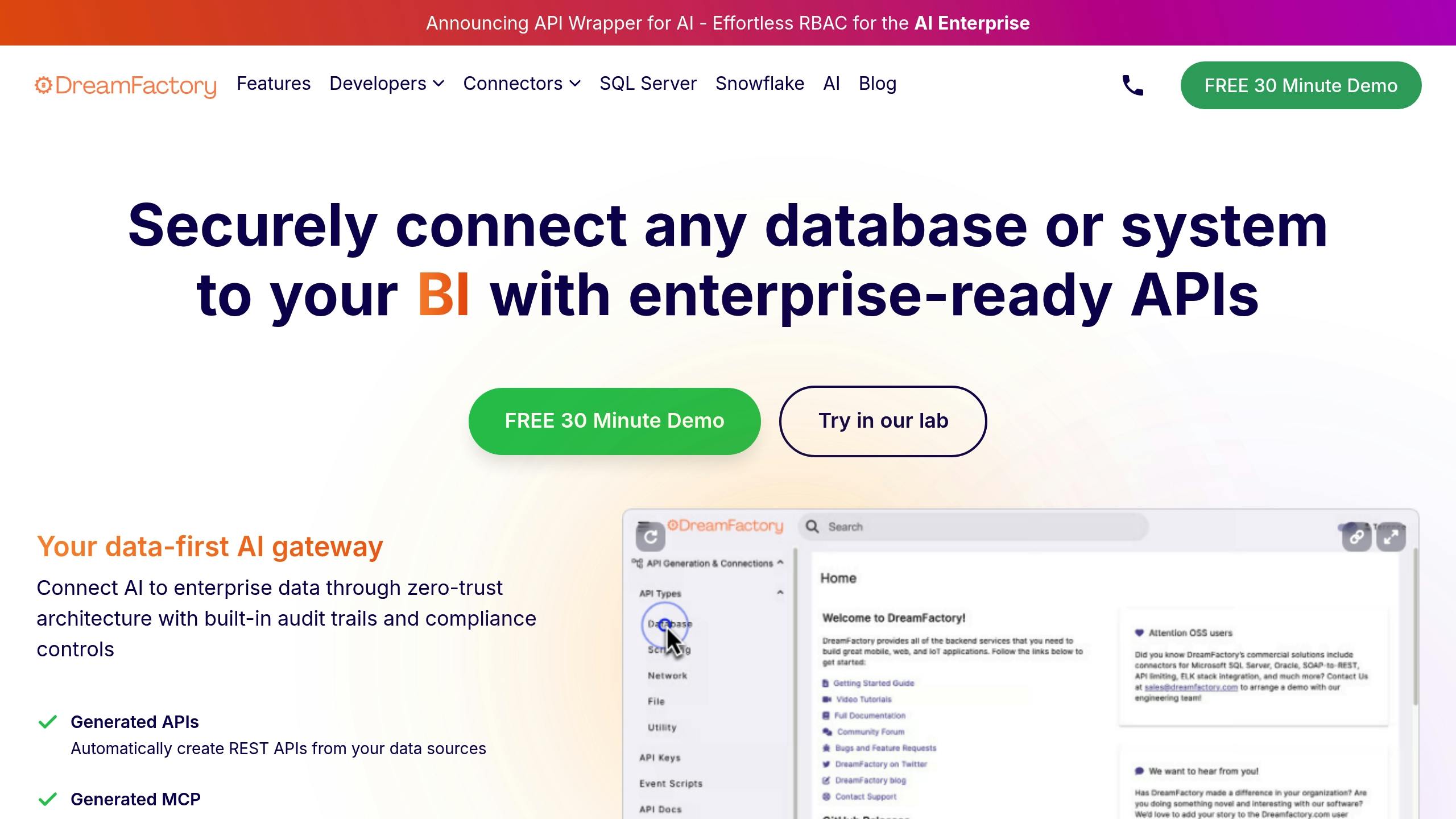Rate limiting and throttling are two key strategies for managing API traffic in multi-tenant systems. While both aim to maintain performance and prevent misuse, they work in different ways:
Rate Limiting: Sets strict caps on the number of requests a user can make within a specific time frame. Extra requests are rejected outright with an HTTP 429 status code.
Throttling: Dynamically adjusts request processing speeds based on system load. Extra requests are slowed down or queued rather than blocked.
Key Differences:
Rate limiting enforces fixed usage limits, while throttling focuses on maintaining system stability during traffic spikes.
Rate limiting is ideal for preventing abuse and enforcing quotas. Throttling is better for ensuring availability during high-demand periods.
Quick Comparison:
|
Feature |
Rate Limiting |
Throttling |
|---|---|---|
|
Purpose |
Enforce usage limits |
Manage traffic surges |
|
Excess Requests |
Rejected outright (HTTP 429) |
Delayed or queued |
|
Flexibility |
Fixed limits |
Dynamic adjustments |
|
Server Load |
Lower |
Higher (due to queue management) |
|
User Impact |
Abrupt denial |
Slower responses |
For subscription-based services with strict usage tiers, rate limiting is the best choice. For unpredictable traffic patterns or real-time applications, throttling ensures smoother performance. Combining both strategies often delivers the best results for multi-tenant API management.
What is Rate Limiting / API Throttling? | System Design Concepts
Rate Limiting in Multi-Tenant APIs
Rate limiting is a crucial tool for managing how many requests each tenant can make within a specific time frame. In multi-tenant environments, it plays a vital role in ensuring that one tenant’s heavy usage doesn’t negatively impact the experience of others. By setting maximum throughput limits, the system can reject or delay extra requests, preserving the overall stability and fairness of your API.
When a tenant surpasses their assigned limits, the API responds with a 429 HTTP status code (Too Many Requests). This blocks further requests until the time window resets. Let’s break down how rate limiting enforces these controls.
How Rate Limiting Works
Rate limiting relies on different algorithms, each with its own strengths and trade-offs. For example:
Fixed window counters reset at regular intervals but can lead to traffic spikes.
Sliding window logs are more precise but consume more memory.
Sliding window counters strike a balance between accuracy and efficiency.
Token bucket and leaky bucket algorithms are ideal for handling burst traffic, allowing immediate requests while controlling the flow rate over time.
In multi-tenant APIs, rate limits are applied at both the tenant and user levels. Limits can also vary by endpoint, reflecting the resource demands of different operations. For instance, simple data retrieval might allow 10,000 requests per hour, while resource-heavy tasks like bulk exports could be capped at 100 requests per hour. During peak demand, fair queuing ensures resources are distributed proportionally.
Tier-specific limits further refine resource management, offering flexibility based on subscription levels:
|
Tier Level |
Request Limit |
Burst Allowance |
Concurrent Connections |
|---|---|---|---|
|
Basic |
10,000/day |
100/minute |
25 |
|
Professional |
50,000/day |
500/minute |
100 |
|
Enterprise |
250,000/day |
2,500/minute |
500 |
|
Custom |
Flexible |
Flexible |
Flexible |
Rate Limiting Benefits
Beyond managing traffic, rate limiting provides several key advantages. It ensures fair access to resources, protects against abuse, and helps maintain consistent performance across the board.
From a security standpoint, rate limiting acts as a frontline defense against threats like denial-of-service attacks, brute-force attempts, and API abuse. With cyberattacks projected to increase by 996% by 2030, these controls are more important than ever. By detecting and blocking suspicious traffic patterns, rate limiting safeguards your API from potential harm.
It also improves performance predictability. By capping request volumes, system administrators can better plan for resource allocation, maintain steady response times, and avoid unexpected infrastructure costs.
Finally, rate limiting helps enforce business models. For example, a basic subscription might include 10,000 requests per day, while enterprise plans offer higher limits and more flexibility. Real-time usage monitoring gives both providers and users the data they need to adapt their strategies, avoid disruptions, and optimize their API integrations efficiently.
Throttling in Multi-Tenant APIs
Throttling adjusts processing rates dynamically based on system load, acting as a traffic regulator to maintain stability during high-demand periods. Unlike rate limiting - which outright rejects excess requests with a 429 status code - throttling slows down or queues requests instead of enforcing rigid limits. This approach ensures service availability without immediately denying access.
In multi-tenant SaaS systems, throttling plays a key role in addressing the "noisy neighbor" problem. By controlling excessive traffic from a single tenant, it prevents one user's activity from negatively impacting others. For example, AWS applies throttling and quota limits across nearly all its service APIs.
How Throttling Works
Throttling relies on algorithms to monitor system resources and adjust request processing speeds as needed. Techniques like token buckets and leaky buckets are commonly used, but instead of rejecting requests outright, they modulate how quickly requests are processed.
When system load increases, throttling mechanisms respond in several ways. Hard throttling rejects requests that exceed system capacity, while soft throttling takes a more flexible approach, such as queuing excess requests or allowing a small percentage to proceed. These mechanisms monitor metrics like CPU usage, memory, database connections, and response times. When stress indicators rise, throttling automatically reduces the processing rate by introducing delays, queuing requests, or limiting concurrent operations. This adaptability is crucial for multi-tenant APIs, as it ensures no single tenant monopolizes resources.
Throttling can be applied at various levels in multi-tenant APIs:
Per-tenant throttling: Limits traffic for individual tenants to prevent any one tenant from overwhelming the system.
Global throttling: Protects the entire infrastructure during peak usage by managing overall traffic.
Resource-specific throttling: Manages components with fixed limits, such as database connections or processing threads.
Benefits of Throttling
Throttling offers several key advantages for managing multi-tenant APIs. The most important is maintaining system stability. By controlling traffic spikes, throttling prevents performance degradation and avoids complete service failures during high-demand periods. Instead of crashing or rejecting requests outright, the system might slow responses, ensuring continued operation.
Another major benefit is consistency. Throttling ensures that excessive traffic from one tenant doesn't disrupt the experience for others. This balance is vital in shared environments, where resource competition could otherwise lead to uneven performance.
Cost management is another advantage, especially in cloud-based systems where resource usage directly impacts expenses. By curbing peak usage, throttling prevents unexpected cost increases during traffic surges while preserving critical operations at reduced capacity.
Finally, throttling enhances predictability. By maintaining steady response times even under varying loads, it helps tenants plan their integrations more effectively. This reduces the risk of timeouts or failed operations, delivering a more reliable experience for all users. These benefits lay the groundwork for a deeper exploration of how throttling compares to rate limiting in multi-tenant APIs.
Rate Limiting vs Throttling: Main Differences
Both rate limiting and throttling are designed to manage API traffic, but they handle excess requests in very different ways. Knowing these differences is key to picking the right approach for your multi-tenant setup.
The main distinction lies in how they deal with traffic overflow. Rate limiting acts like a strict gatekeeper - once the limit is reached, any extra requests are simply blocked until the next time window. Throttling, by contrast, operates more like a traffic signal, slowing down the flow of requests instead of outright rejecting them. Let’s break this down further.
Rate Limiting vs Throttling Comparison
Here’s a side-by-side look at how these two methods stack up:
|
Feature |
Rate Limiting |
Throttling |
|---|---|---|
|
Primary Purpose |
Prevent misuse and enforce fair usage |
Maintain stable performance during traffic spikes |
|
What Happens to Extra Requests |
Rejected outright (HTTP 429) |
Delayed or queued for later processing |
|
Implementation |
Fixed-window counters or token bucket methods |
Dynamic algorithms to adjust speed |
|
Response Behavior |
Immediate accept or reject |
Controlled delay |
|
Server Load |
Lower, as excess requests are not processed |
Higher, due to queue management |
|
User Impact |
Abrupt denial of requests when limits are hit |
Slower responses instead of outright failures |
|
Reset/Adjustment |
Resets at the start of a new time window |
Continuously adapts to current traffic |
|
Flexibility |
Less flexible, with fixed limits |
More adaptive, adjusts in real-time |
|
Best Use Case |
Enforcing usage limits and preventing abuse |
Handling sudden traffic spikes while maintaining service quality |
Rate limiting provides clear, immediate boundaries, helping reduce server strain by rejecting extra requests outright. This predictability can also help users better understand their usage limits.
Throttling, on the other hand, focuses on keeping services running smoothly during high-demand periods. Instead of blocking users, it slows things down, ensuring everyone gets some level of access. However, this approach often comes with the trade-off of increased complexity and higher resource use.
When to Use Rate Limiting vs Throttling
The best choice depends on the specific challenges of your multi-tenant environment and your priorities.
Rate limiting is ideal when you need strict control and predictable behavior. For instance, in SaaS platforms with tiered pricing, clear boundaries ensure fair resource distribution and prevent abuse. It’s also highly effective for security purposes. In fact, a 2023 survey by Alibaba Cloud found that 78% of developers view API abuse as a top concern. Tools like Cloudflare’s rate limiting systems blocked 12.8 million DDoS attacks in Q3 2023 alone, highlighting its effectiveness in combating large-scale threats.
Throttling shines when uninterrupted service is your top priority. During high-traffic events like flash sales or product launches, throttling ensures your API remains functional by slowing down rather than rejecting requests. This is especially valuable for real-time applications like chat platforms, live dashboards, or collaborative tools, where a complete service outage would be far more disruptive than slower response times.
Ultimately, the decision hinges on what matters most: minimizing service interruptions or managing resource consumption. If consistent availability is critical and you can handle the extra server load, throttling might be the better choice. On the other hand, if you need strict control and want to keep overhead low, rate limiting is the way to go. Many teams find that combining both strategies - using rate limiting to enforce quotas and throttling to manage traffic spikes - delivers the best balance of security and availability for their multi-tenant systems.
Multi-Tenant API Management Best Practices
Managing resources in a multi-tenant environment can be tricky, especially when it comes to balancing rate limiting and throttling. The goal is to create policies that prevent one tenant from negatively affecting others while ensuring resources are used efficiently.
Setting Up Per-Tenant Policies
A solid multi-tenant API management strategy starts with setting limits at multiple levels. This helps address different resource consumption scenarios and avoids the "noisy neighbor" problem, where one tenant hogs resources to the detriment of others.
Here’s how you can break it down:
Tenant-Level Limits: Allocate overall capacity based on service tiers. For example, premium tenants might get 10,000 requests per hour, while basic tenants are limited to 1,000.
User-Level Limits: Set caps for individual users within each tenant. For instance, a user might be restricted to 25% of the tenant's total quota.
Endpoint-Specific Limits: Adjust limits based on the resource demands of specific operations, like stricter controls on write operations compared to read queries.
In microservices architectures, distribute these limits across instances to simplify enforcement, even if it means some level of approximation. Additionally, adaptive limits can dynamically adjust thresholds based on system load. For instance, during low usage periods, tenants might temporarily enjoy higher limits, while limits tighten automatically when demand spikes to maintain stability.
Monitoring and Adjusting Limits
Real-time monitoring is crucial for effective rate limiting. By tracking usage continuously, you can dynamically adjust limits and keep tenants informed about their remaining quota. Clear error messages when limits are exceeded help developers understand what went wrong and when they can retry. Providing programmatic access to quota information through dedicated endpoints allows applications to adapt to available resources.
To prevent sudden disruptions, implement warning thresholds - such as notifications at 75% and 90% of capacity - so tenants can adjust before hitting hard limits. Additionally, system conditions can trigger automatic adjustments to maintain performance. Here’s an example of how this might work:
|
Condition |
Adjustment Action |
Recovery Period |
|---|---|---|
|
High System Load |
Reduce limits by 25% |
15 minutes |
|
Database Congestion |
Throttle write operations |
5 minutes |
|
Network Saturation |
Decrease concurrent connections |
10 minutes |
|
Low Resource Usage |
Increase limits by 10% |
30 minutes |
Analyzing historical data can also guide long-term policy adjustments. For example, tenants consistently hitting their limits might benefit from upgrading to a higher tier, while those with occasional spikes might need temporary burst capacity.
A layered monitoring approach ensures comprehensive coverage. Combine coarse-grained rate limiting at the API gateway, service-to-service rate limiting in the service mesh, and fine-grained, context-aware rate limiting at the application level. This tiered strategy ensures dynamic adjustments are both effective and manageable.
Using DreamFactory for API Management

DreamFactory simplifies the process of implementing these best practices. Its robust API management capabilities make it easy to configure granular limits tailored to multi-tenant environments.
You can set limits for specific users, roles, services, or endpoints, with support for different HTTP methods. Flexible timeframes - such as minute, hourly, daily, weekly, or monthly - allow you to align technical controls with billing cycles and usage trends.
DreamFactory also includes built-in security features like role-based access control (RBAC), API key management, and OAuth integration to ensure all tenants are consistently protected. With server-side scripting, you can customize settings for individual tenants without altering the platform’s core functionality.
The platform’s API-driven management tools, such as the /api/v2/system/limit and /api/v2/system/limit_cache endpoints, enable automated adjustments. These can be triggered by external events like billing updates or system monitoring alerts.
With support for over 20 database connectors - including Snowflake, SQL Server, and MongoDB - DreamFactory ensures your rate limiting policies are consistently applied across various data sources. This simplifies management in complex, multi-database setups.
Conclusion
Rate limiting and throttling are essential tools for managing multi-tenant APIs, each serving a unique yet complementary purpose in maintaining stability and fairness. While rate limiting enforces strict quotas, throttling dynamically regulates the flow of requests to handle varying traffic patterns effectively.
Consider this: 80% of users will uninstall an app after encountering just three performance issues. That statistic underscores the importance of these mechanisms in ensuring API availability and preventing resource overload.
The choice between rate limiting and throttling depends on your specific API requirements. If you need to enforce strict usage quotas - such as in subscription-based services - rate limiting is the way to go. On the other hand, throttling is better suited for managing traffic surges, ensuring a smooth user experience during unexpected spikes.
The best results often come from combining both strategies alongside robust monitoring and adaptive policies. Features like tiered limits, real-time adjustments, and tenant-specific configurations can help prevent issues like the "noisy neighbor" problem while ensuring optimal performance for all users. This balanced approach not only addresses potential resource conflicts but also supports efficient API management across tenants.
Platforms like DreamFactory simplify this process by offering built-in security features, flexible configurations, and automation tools. With its API-driven management capabilities, DreamFactory ensures that your rate limiting and throttling policies are consistently applied, even in complex, multi-database environments. This ensures your multi-tenant API ecosystem remains secure, efficient, and reliable.
FAQs
Rate limiting and throttling play crucial roles in managing multi-tenant APIs, each serving a distinct purpose. Rate limiting sets a hard limit on how many requests a tenant can make within a defined time frame. This ensures fair usage across tenants and prevents the system from being overwhelmed.
Meanwhile, throttling steps in during traffic surges, slowing down or queuing requests to keep performance steady. This dynamic approach helps maintain stability when demand spikes unexpectedly.
When used together, these tools create a balanced system. They allocate resources fairly, uphold system reliability, and provide a smooth experience for all tenants. By combining fixed limits with flexible traffic management, you can protect your API from misuse while supporting growth in a multi-tenant environment.
Rate-limiting algorithms like fixed window, sliding window, leaky bucket, token bucket, and sliding log are commonly used to manage the flow of incoming API requests. These methods ensure fair usage across users and help protect systems from being overwhelmed.
Among these, the token bucket and leaky bucket algorithms are particularly popular due to their ability to handle traffic bursts effectively. They allow occasional surges in requests while keeping overall traffic under control. This balance is crucial for maintaining API performance, as it minimizes delays and optimizes resource use - especially in environments where multiple users share the same system.
Throttling plays a key role in multi-tenant APIs, especially when managing consistent performance during traffic surges is critical. While rate limiting enforces a fixed cap on requests within a specific timeframe, throttling takes a more flexible approach by dynamically moderating request flow. This helps prevent system overloads while keeping services accessible.
This method is particularly effective when tenant usage patterns are hard to predict. Throttling allows resources to be distributed more evenly without outright denying requests, ensuring a smoother experience for all users - even during peak demand periods.
Terence Bennett, CEO of DreamFactory, has a wealth of experience in government IT systems and Google Cloud. His impressive background includes being a former U.S. Navy Intelligence Officer and a former member of Google's Red Team. Prior to becoming CEO, he served as COO at DreamFactory Software.
























 Blog
Blog


